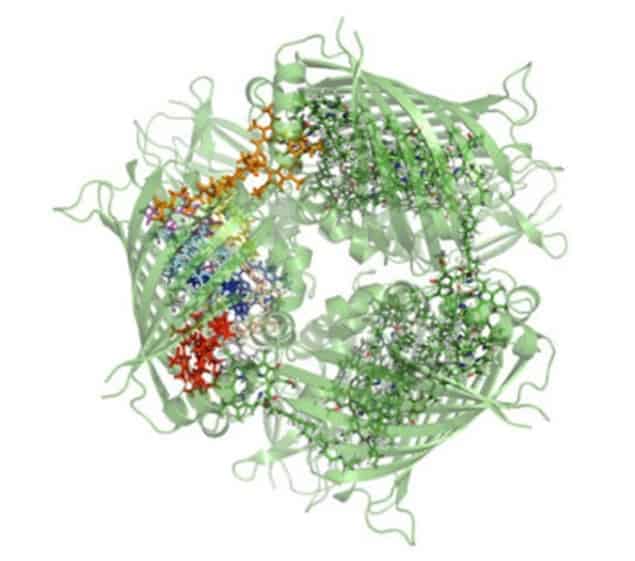
A new theory of how plant photosynthesis involves quantum coherence has been suggested by physicists in the UK, Germany and Spain. This latest research is based on the study of organisms that live deep under the sea yet are able to convert sunlight into energy. The study suggests that molecular vibrations do not destroy the coherence – as previously thought – but rather perpetuate and even regenerate coherence. The discovery provides a better understanding of how as much as 99% of the energy of light absorbed by photosynthesis cells is successfully transferred to locations in the cells where electric energy is converted to chemical energy. The work opens up the possibility of using nature-inspired designs in quantum devices.
Until recently, living systems were thought to be “too wet and warm” to rely on delicate quantum properties such as entanglement and coherence. The problem is that these properties decay rapidly via random interactions with things in the outside world, such as vibrating molecules. However, over the past decade physicists have begun to suspect that quantum properties play important roles in biochemical processes – including photosynthesis.
This latest work was done by Alex Chin (now at Cambridge University) and colleagues at the Institute of Theoretical Physics in Ulm and the Technical University of Cartagena. The team looked at organisms called green sulphur bacteria that live 2000 m below the ocean surface. There is so little sunlight down there that the bacteria cannot afford to lose a single photon – indeed, almost 100% of the light they absorb is turned into food.
Excited states
When sunlight hits the surface of the plant, energy is transferred via chains of pigments to a reaction centre, where it is converted into chemical energy. Those pigments are held in place by proteins, which together create pigment–protein complexes, or PPCs. The PPCs effectively act as corridors and the energy itself travels in the form of molecular excited states, or molecular excitons. These excitons are able to move along the PPC by hopping from one molecule to the next.
In 2007 Graham Fleming and colleagues in the US showed that these excitons exhibit quantum coherence, which means that the excitons may exist simultaneously in a superposition of several quantum states with varying probabilities. Coherence also allows the exciton to explore multiple pathways to the reaction centre simultaneously, ultimately choosing the fastest, most efficient option. As is demonstrated in man-made solar cells (which also rely on excitons), the longer this trip takes, the more likely it is that the energy will dissipate before it reaches its destination.
Optimizing function
The presence of quantum effects in photosynthesis surprised both physicists and biologists, and left them wondering how a fragile quantum state could survive in a living organism. More specifically, research groups found that the coherenent states exist for 100-times longer than the coherence time of the energy states of an exciton. Something was helping these wave states survive long enough to ensure the safe passage of nearly 100% of the photon energy that the organisms absorbed.
This latest research suggests that the answer lies in the proteins in the PPCs, which provide structural support for the pigment molecules. The new calculations reveal that these proteins are more active participants in the transport system than was previously thought. The natural vibration frequencies of the proteins resonate with the exciton waves, and like a parent pushing a child on a swing, the protein structures keep the excitons oscillating without dampening. In fact, the exciton may pass its vibration into the protein structures, which then return it to the exciton, thus restoring its coherence.
“People have not viewed this protein structure as something that actively helps quantum phenomenon to take place in biological systems,” says team member Martin Plenio. “This is really a new way of thinking about things.”
Definitely not noise
The team’s conclusions come from precise analysis of the protein vibrations, using data from Markus Wendling and colleagues in the Netherlands, who in 2000 examined the PPC structures from green sulphur bacteria. Previous efforts to study the protein vibrations used rougher approximations and usually concluded that the vibrations were noise.
“The main difference in terms of the paradigm for doing this simulation was to not separate the system into the exciton and the environment, but to treat them all together as one large many-body system,” says Chin. “We took a completely holistic approach. This makes it very complicated in terms of variables and things that one has to keep track of, which means that computationally it is very tough.”
Understanding these protein structures could assist in building similar structures in quantum devices. If similar structures are used in the conversion of electrical energy to chemical energy, it could shed light on how to mimic photosynthesis’s high efficiency rates in man-made solar cells.
A good hypothesis
Greg Scholes of the University of Toronto in Canada praises the detailed analysis conducted by the team, and says the conclusions “fit with some of the pieces of the puzzle that have been emerging in more recent experiments”.
While Scholes believes the analysis is “sufficient proof of the idea in principle”, he says direct experiments will need to be done to confirm the conclusions. “From that perspective this work really contributes something important. Because it gives us a hypothesis, [and now] we can go and test it,” he says.
The study is described in Nature Physics.



